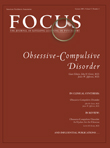Obsessive-Compulsive Disorder
Abstract
OCD, a surprisingly common disorder, is often hidden by patients who have insight into the inappropriateness of their obsessional concerns and the excessive rituals they feel compelled to perform to ward off exceedingly low risk danger or more vague feelings of discomfort. Onset in childhood is common and many suffer lifelong with a few becoming incapacitated by incessant demands of their disorder.
Diagnosis is straightforward once obsessions and rituals are admitted. Once recognized, treatment with cognitive behavior therapy (CBT) and potent serotonin reuptake inhibitors (SRIs) is often helpful, alone or in combination. For those with disorders unresponsive to these standard treatments, somatic treatment with multiple medications and rarely, deep brain stimulation or neurosurgical lesions may be helpful. The largest obstacle to effective treatment of OCD at present is the difficulty obtaining effective CBT which is twice as beneficial, on average, as SRIs.



